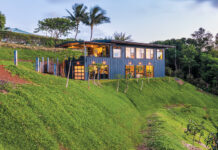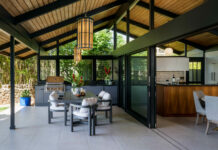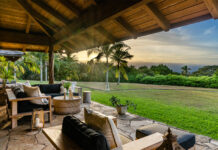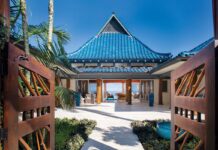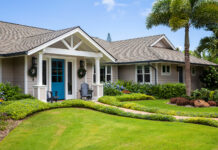Story by Rita Goldman | Photos courtesy of Blu Homes
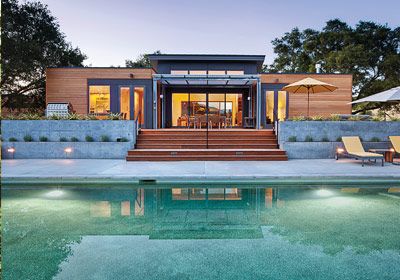 When scientists at California’s Lawrence Livermore National Laboratory wanted to design a space telescope forty times larger than the Hubble, they turned to Robert Lang for help. Lang is an engineer and physicist, but what made him vital to the mission was his passion for origami. To travel into space aboard a very small rocket, that football-field-sized lens would have to fold — and not just any which-way, or its optical capabilities would be irreparably damaged.
When scientists at California’s Lawrence Livermore National Laboratory wanted to design a space telescope forty times larger than the Hubble, they turned to Robert Lang for help. Lang is an engineer and physicist, but what made him vital to the mission was his passion for origami. To travel into space aboard a very small rocket, that football-field-sized lens would have to fold — and not just any which-way, or its optical capabilities would be irreparably damaged.
An origami aficionado, Lang had created a computer program that analyzes patterns for constructing complex folded shapes. And although funding for the enormous Eyeglass Telescope unfortunately folded before it could be built, a scale model performed perfectly.
Origami makes possible a surprising array of objects that need to be large at their destination, but small in transit — everything from a spaceship’s solar sail, to a stent that enlarges a clogged vein or artery after traveling through the blood vessel in a collapsed origami pattern.
Folding technology may soon change the kinds of homes Hawai‘i residents live in.
New Efficient Home Designs Coming to Maui?
It’s been happening on the mainland since 2008, when environmental entrepreneur Bill Haney and venture capitalist Maura McCarthy launched Blu Homes: architecturally designed dwellings that get assembled in a 250,000-square-foot factory in California, folded up to fit on a standard truck, shrink-wrapped, shipped, and unfolded at their destination. The homes arrive 80 to 90 percent complete — right down to appliances, plumbing, and cabinetry — and are LEED certifiable, to boot. Installation takes a fraction of the time of conventional construction, so the savings on labor are dramatic.
Since that all sounds too good, or at least too easy, to be true, we asked Lars Wernars, owner of Cutting Edge Development, about Blu Homes. Wernars’s crew handled the award-winning renovation of Napili Kai Resort (“Oceanfront, Earth Friendly,” MNKO July/August 2012), and recently signed on as Blu Homes’ Hawai‘i consultant.
“I was interested in bringing a quality green product to Hawai‘i,” Wernars says. “Most prefab homes are for low-end markets, so they make everything cheaply. These guys [Blu Homes] use highly rated, nontoxic and recyclable materials. In my custom homes, I try to achieve what they’re doing. I’ve been to the factory, toured four or five Blu Homes in northern California. They have LEED-accredited people on staff; you don’t see that often with premanufactured homes.”
Blu Homes already sells throughout the contiguous U.S. and in Canada, but Hawai‘i is surely a horse — or a home — of a different color. Can modular units with relatively flat roofs be comfortable and energy efficient in the subtropics, where traditional architecture relied on pitched roofs and deep eaves for climate control? What about other environmental factors?
Stephen Meder would know. A professor of architecture with the University of Hawai‘i at Manoa, Dr. Meder directs the Center for Smart Building and Community Design, and the university’s Environmental Systems Laboratory.
“Prefabricated homes use materials efficiently,” Meder says, “but it helps to have data on the resource, energy, and greenhouse-gas savings of a particular prefab method compared with the conventional stick-frame house. That equation will look different in Hawai‘i because of shipping, but we’re so isolated here that, unless you’re building a moss-rock house, you’re shipping materials anyway.” And if the materials all arrive at once, folded into a Matson-sized container, the carbon footprint can be smaller.
As for climate: “Even a shed roof can be good, if it’s oriented the right way for solar and photovoltaic,” says Meder. “I’d ask about the siting, ventilation, and thermal control of the building envelope — especially the roof, but also the walls and windows, and how they mitigate solar [heat] gains. The average condition in Hawai‘i is warm and humid, with intense solar impacts. How do they deliver comfort without relying on air conditioning?”
Brett Chisholm, Blu Homes’ vice-president of sales, says that on the mainland, the company’s designers and architects can walk around a property and determine where to set and how to orient the house for optimum airflow, passive heating and cooling. Here on Maui, that role will likely fall to Wernars and other local contractors familiar with the Islands’ weather patterns.
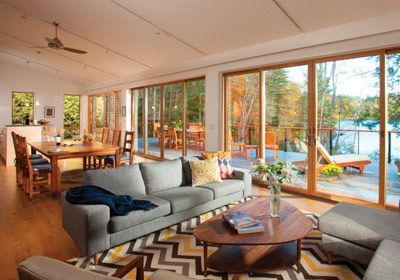 “The most heat gain in a house is in the roof,” says Wernars. That’s especially true in Hawai‘i, whose latitude puts the sun directly overhead more hours of the day, more days of the year. “If you have a roof of thick concrete and no insulation, it sits in the sun and absorbs the heat, then radiates into the house all night. The best-case scenario is to build with materials that have very little heat gain, such as standing-seam roofing [a thin metal layer that can’t absorb much heat], plus very good insulation. Blu Homes uses SIP — structural insulated panels that combine high strength with very good insulating properties. You can sit them in the baking sun in Hawai‘i, and have very little heat transference into the home.”
“The most heat gain in a house is in the roof,” says Wernars. That’s especially true in Hawai‘i, whose latitude puts the sun directly overhead more hours of the day, more days of the year. “If you have a roof of thick concrete and no insulation, it sits in the sun and absorbs the heat, then radiates into the house all night. The best-case scenario is to build with materials that have very little heat gain, such as standing-seam roofing [a thin metal layer that can’t absorb much heat], plus very good insulation. Blu Homes uses SIP — structural insulated panels that combine high strength with very good insulating properties. You can sit them in the baking sun in Hawai‘i, and have very little heat transference into the home.”
Inside, Blu Home uses Energy Star appliances, recycled steel framing, paint that doesn’t off-gas, formaldehyde-free cabinets of sustainably harvested wood, and flooring options that include bamboo, reclaimed and Forest Stewardship Council woods.
Rust Prevention in Hawaii Homes
For Hawai‘i, Lars Wernars advised them to go even further.
“The main thing was upgrading rust prevention,” he says. “You cannot build a house in Hawai‘i with iron or steel unless it’s protected from corrosive salt — the whole steel structure — or something can rust inside your house and you won’t see it. Our trade winds travel over 2,000 miles of open ocean, picking up salt. The atmosphere here is permeated with it, even up in Kula. When Cutting Edge does custom homes, we do anticorrosive painting, even on the inside walls. Blu Homes will do that as standard treatment.”
Blu Homes’ steel construction uses much less wood; still, termites were another concern. Chisholm says all interior wood is treated with borate, a naturally occurring wood protector with low toxicity — unless you’re a termite. The company also offers fiber-cement siding with the look, but none of the chewability, of wood.
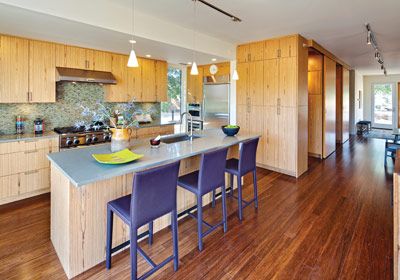 All that environmental friendliness aside, what impressed us about Blu Homes was what its folding technology makes possible. All eight models are airy, attractive and customizable, and because the homes fold into a twenty- to forty-foot container, they can be delivered much more cost-effectively. “If you can get a Matson container up your road,” says Wernars, “you can get a Blu Home.”
All that environmental friendliness aside, what impressed us about Blu Homes was what its folding technology makes possible. All eight models are airy, attractive and customizable, and because the homes fold into a twenty- to forty-foot container, they can be delivered much more cost-effectively. “If you can get a Matson container up your road,” says Wernars, “you can get a Blu Home.”
Once there, that steel framing unfolds to reveal rooms up to twenty-five feet wide, with ceilings as high as sixteen feet, and entire glass walls. And it can do so in as little as a single day — though finishing touches, including plumbing hookups, drywalling and painting at the folds, take another two to four weeks. On the mainland, prices start at $130,000 for the basic Origin model, which includes everything from design to appliances to delivery and installation. With the cost of shipping to the Islands, you can expect prices to increase. Even so, Blu Homes could help ease Hawai‘i’s pressing need for affordable housing by dramatically reducing the cost of labor.
And that’s where we found the one drawback to bringing prefabricated homes to Hawai‘i: fewer local jobs.
“You can’t bring good, energy-efficient homes to market, all made in Hawai‘i, and have them be affordable,” says Wernars. “The labor force here costs twice what it does in other places in the U.S. You can hire a carpenter in Utah for $15 an hour. For that same carpenter to be able to live in Hawai‘i, he needs to make $35 an hour.”
Blu Homes will still require local labor to prepare the site, pour foundations, hoist the modules by crane and set them on the slabs, and do the finishing work. “From the time the modules arrive in Hawai‘i by barge, we’ll be working with local people,” Chisholm says.
And if the company can deliver truly affordable homes, increased orders could translate into more jobs for workers in those areas.
Lars Wernars takes the long view. “Prefabrication requires less of my time and attention as a contractor, so I’ll make less money, too. But I believe that if we really want to meet the need for durable, affordable homes, and get Hawai‘i energy independent, we have to think outside the box . . . and get the box.”
Visit bluhomes.com to see the company’s eight different models — and configure one yourself.

